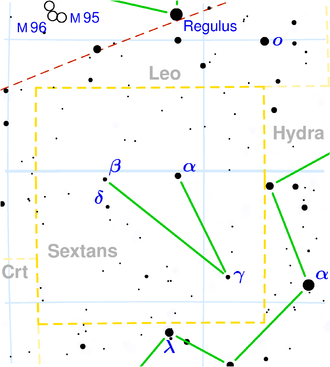NGC 3110
| Galaxy NGC 3110 / NGC 3122 / NGC 3518 |
|
|---|---|
![NGC 3110 with LEDA 29184 [1], Pan-STARRS](https://upload.wikimedia.org/wikipedia/commons/thumb/2/2a/NGC_3110_PanS.png/300px-NGC_3110_PanS.png)
|
|
| NGC 3110 with LEDA 29184, Pan-STARRS | |
| AladinLite | |
| Constellation | sextant |
|
Position equinox : J2000.0 , epoch : J2000.0 |
|
| Right ascension | 10 h 04 m 02.1 s |
| declination | -06 ° 28 ′ 29 ″ |
| Appearance | |
| Morphological type | SB (rs) b / pec / HII / LIRG |
| Brightness (visual) | 12.7 mag |
| Brightness (B-band) | 13.5 likes |
| Angular expansion | 1.6 ′ × 0.8 ′ |
| Position angle | 162 ° |
| Surface brightness | 12.8 mag / arcmin² |
| Physical data | |
| Redshift | 0.016858 ± 0.000029 |
| Radial velocity | 5054 ± 9 km / s |
|
Stroke distance v rad / H 0 |
(218 ± 15) x 10 6 ly (66.9 ± 4.7) Mpc |
| history | |
| discovery | William Herschel |
| Discovery date | March 5, 1785 |
| Catalog names | |
| NGC 3110/3122/3518 • PGC 29192 • MCG -01-26-014 • IRAS 10015-0614 • 2MASX J10040212-0628291 • GC 2011 • H II 305 • HIPASS J1004-06 • LDCE 699 NED003 | |
NGC 3110 = NGC 3122 = NGC 3518 is an active spiral galaxy with extensive star formation areas of the Hubble type Sb and is located in the constellation Sextant south of the celestial equator . It is estimated to be 218 million light years away from the Milky Way and has a diameter of around 100,000 ly . Together with PGC 29184 , it forms a gravitationally bound galaxy pair .
In the same area of the sky is u. a. the galaxy IC 589 .
The object was discovered by Wilhelm Herschel on March 5, 1785 .
